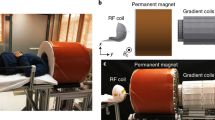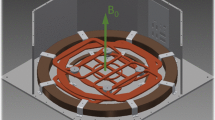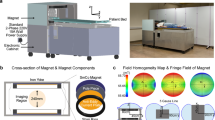Abstract
Objectives
The need for affordable and appropriate medical technologies for developing countries continues to rise as challenges such as inadequate energy supply, limited technical expertise, and poor infrastructure persist. Low-field magnetic resonance imaging (LF MRI) is a technology that can be tailored to meet specific imaging needs within such countries. Its low power requirements and the possibility of operating in minimally shielded or unshielded environments make it especially attractive. Although the technology has been widely demonstrated over several decades, it is yet to be shown that it can be diagnostic and improve patient outcomes in clinical applications. We here demonstrate the robustness of prepolarizing MRI (PMRI) technology for assembly and deployment in developing countries for the specific application to infant hydrocephalus. Hydrocephalus treatment planning and management requires only modest spatial resolution, such that the brain can be distinguished from fluid—tissue contrast detail within the brain parenchyma is not essential.
Materials and Methods
We constructed an internally shielded PMRI system based on the Lee-Whiting coil system with a 22-cm diameter of spherical volume.
Results
In an unshielded room, projection phantom images were acquired at 113 kHz with in-plane resolution of 3 mm × 3 mm, by introducing gradient fields of sufficient magnitude to dominate the 5000 ppm inhomogeneity of the readout field.
Discussion
The low cost, straightforward assembly, deployment potential, and maintenance requirements demonstrate the suitability of our PMRI system for developing countries. Further improvement in image spatial resolution and contrast of LF MRI will broaden its potential clinical utility beyond hydrocephalus.









Similar content being viewed by others
References
Kahle KT, Kulkarni AV, Limbrick DD Jr, Warf BC (2016) Hydrocephalus in children. Lancet 387(10020):788–799
Warf BC (2005) Hydrocephalus in Uganda: the predominance of infectious origin and primary management with endoscopic third ventriculostomy. J Neurosurg 102(1 Suppl):1–15
Warf BC, Alkire BC, Bhai S, Hughes C, Schiff SJ, Vincent JR, Meara JG (2011) Costs and benefits of neurosurgical intervention for infant hydrocephalus in sub-Saharan Africa. J Neurosurg Pediatr 8(5):509–521
Kulkarni AV, Schiff SJ, Mbabazi-Kabachelor E, Mugamba J, Ssenyonga P, Donnelly R, Levenbach J, Monga V, Peterson M, MacDonald M, Cherukuri V, Warf BC (2017) Endoscopic treatment versus shunting for infant hydrocephalus in Uganda. N Engl J Med 377(25):2456–2464
Rooney WD, Johnson G, Li X, Cohen ER, Kim SG, Ugurbil K, Springer CS Jr (2007) Magnetic field and tissue dependencies of human brain longitudinal 1H2O relaxation in vivo. Magn Reson Med 57:308–318
Klein H-M (2016) clinical low field strength magnetic resonance imaging: a practical guide to accessible MRI. Springer, New York
Muhogora WE et al (2010) Paediatric CT examinations in 19 developing countries: frequency and radiation dose. Radiat Prot Dosim 140(1):49–58
Brenner DJ, Hall EJ (2007) Computed tomography—an increasing source of radiation exposure. N Engl J Med 357(22):2277–2284
Sepponen RE, Sipponen JT, Sivula A (1985) Low field (0.02 T) nuclear magnetic resonance imaging of the brain. J Comput Assist Tomogr 9(2):237–241
Nascimento GCD, Engelsberg M, Souza RED (1992) Digital NMR imaging system for ultralow magnetic fields. Meas Sci Technol 3(4):370–374
Macovski A, Conolly S (1993) Novel approaches to low-cost MRI. Magn Reson Med 30(2):221–230
Matter NI, Scott GC, Grafendorfer T, Macovski A, Conolly SM (2006) Rapid polarizing field cycling in magnetic resonance imaging. IEEE Trans Med Imaging 25(1):84–93
Savukov I, Karaulanov T, Castro A, Volegov P, Matlashov A, Urbatis A, Gomez J, Espy M (2011) Non-cryogenic anatomical imaging in ultra-low field regime: hand MRI demonstration. J Magn Reson 211:1–23. https://doi.org/10.1016/j.jmr.2011.05.011
Savukov MI, Karaulanov T (2013) Magnetic-resonance imaging of the human brain with an atomic magnetometer. Appl Phys Lett 103:1–4
Lother S, Schiff SJ, Neuberger T, Jakob PM, Fidler F (2016) Design of a mobile, homogeneous, and efficient electromagnet with a large field of view for neonatal low-field MRI. Magn Reson Mater Phy 29:1–8
Sarracanie M, LaPierre CD, Salameh N, Waddington DEJ, Witzel T, Rosen MS (2015) Low-cost high-performance MRI Sci Rep 5:15177
Halbach K (1980) Design of permanent multipole magnets with oriented rare earth cobalt material. Nucl Instrum Methods 169:1–10
Kimura T, Geya Y, Terada Y, Kose K, Haishi T, Gemma H, Sekozawa Y (2011) Development of a mobile magnetic resonance imaging system for outdoor tree measurements. Rev Sci Instrum 82(5):053704
Kose K, Haishi T (2011) High resolution NMR imaging using a high field yokeless permanent magnet. Magn Reson Med Sci 10:159–167
Cooley CZ, Stockmann JP, Armstrong BD, Sarracanie M, Lev MH, Rosen MS, Wald LL (2015) Two-dimensional imaging in a lightweight portable MRI scanner without gradient coils. Magn Reson Med 73(2):872–883
Blümler P, Casanova F (2016) Hardware developments: Halbach magnet arrays. In: Johns ML, Fridjonsson EO, Vogt SJ, Haber A, Price W (eds) Mobile NMR and MRI: developments and applications. The Royal Society of Chemistry, Cambridge, pp 133–157
Morgan P, Conolly S, Scott G, Macovski A (1996) A readout magnet for prepolarized MRI. Magn Reson Med 36(4):527–536
Kirschvink JL (1992) Uniform magnetic-fields and double-wrapped coil systems—improved techniques for the design of bioelectromagnetic experiments. Bioelectromagnetics 13(5):401–411
Merritt R, Purcell C, Stroink G (1983) Uniform magnetic field produced by three, four, and five square coils. Rev Sci Instrum 54(7):879–882
Rubens SM (1945) Cube-surface coil for producing a uniform magnetic field. Rev Sci Instrum 16(9):243–245
Gottardi G, Mesirca P, Agostini C, Remondin D, Bersani F (2003) A Four coil exposure system (tetracoil) producing a highly uniform magnetic field. Bioelectromagnetics 24(2):125–133
Wire industries MWS. World’ s largest selection of specialty magnet wire. Available at: http://www.mwswire.com/pdf_files/mws_tech_book/techbook2016.pdf. Accessed 4 Apr 2018
Hidalgo TS (2010) Theory of gradient coil design methods for magnetic resonance imaging. Concepts Magn Reson Part A 36A(4):223–242
Golay MJE (1958) Field homogenizing coils for nuclear spin resonance instrumentation. Rev Sci Instrum 29(4):313–315
Hoult DI (1978) The NMR receiver: a description and analysis of design. Prog Nucl Magn Reson Spectrosc 12(1):41–77
Henry OW (2009) Electromagnetic compatibility engineering. John Wiley & Sons, New York
Schulz RB, Huang GC, Williams WL (1968) RF shielding design. IEEE Trans Electromagn Compat EMC-10(1):168–175. https://doi.org/10.1109/TEMC.1968.302925
Kedzia P, Czechowski T, Baranowski M, Jurga J, Szcześniak E (2013) Analysis of uniformity of magnetic field generated by the two-pair coil system. Appl Magn Reson 44(5):605–618
Sarracanie M et al (2015) Low-cost high-performance MRI. Sci Rep 5:15177
Ginsberg DM, Melchner MJ (1970) Optimum geometry of saddle shaped coils for generating a uniform magnetic field. Rev Sci Instrum 41(1):122–123
Samila A (2015) Simulation of magnetic field topology in a saddle-shaped coil of nuclear quadrupole resonance spectrometer. Prog Electromagn Res Lett 56:67–73
Hinshaw WS, Bottomley PA, Holland GN (1977) Radiographic thin-section image of the human wrist by nuclear magnetic resonance. Nature 270(5639):722–723
Rashid SA, Amiruddin BS, Chew TH (2008) Magnetic field simulation of Golay coil. J Fundam Sci 4:353–361
Acknowledgements
This work was funded by the Endowment funds of Harvey F. Brush at Penn State University, US Department of Energy Los Alamos National Laboratory Directed Research and Development program (IMS), and US National Institutes of Health Director's Pioneer Award 5DP1HD086071 (SJS).
Author information
Authors and Affiliations
Contributions
JO: Responsible for winding magnet coils and carrying out imaging experiments. JRH: Responsible for solid work Computer Aided Designs (CAD) of the magnet and coil systems and for image analysis. SC: Responsible for theoretical analysis of magnetic field uniformity for the designs. ST: Participated in designing and building radio frequency amplifiers. TN: Participated in radio frequency tuning of coils, and contributed to image analysis. IMS: Consulted on all aspects of device design, wrote the labview program used in imaging, and helped carry out imaging experiments. SJS: Overall supervisor for the concept, design, implementation, and analysis for the project.
Corresponding author
Ethics declarations
Conflict of interest
Author IMS has received research support from the US Los Alamos National Laboratory’s Laboratory Directed Research and Development program. Author SJS has received support from the Endowment funds of Harvey F. Brush at Penn State University, and from the US NIH National Institutes of Health Director's Pioneer Award Grant 5DP1HD086071.
Ethical standard
The study was conducted under the scientific ethics guidelines of The Pennsylvania State University, and in accordance with the use of US NIH funding. There were no human or animal research subjects. No study advertising was made and no remuneration was offered.
Rights and permissions
About this article
Cite this article
Obungoloch, J., Harper, J.R., Consevage, S. et al. Design of a sustainable prepolarizing magnetic resonance imaging system for infant hydrocephalus. Magn Reson Mater Phy 31, 665–676 (2018). https://doi.org/10.1007/s10334-018-0683-y
Received:
Revised:
Accepted:
Published:
Issue Date:
DOI: https://doi.org/10.1007/s10334-018-0683-y




